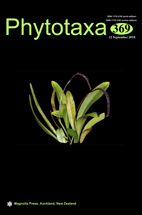Abstract
The family Parmulariaceae comprises three polyphyletic genera, but with very little data in GenBank and is presently placed in the order Asterinales. In this study, we re-analyze the available sequence data for taxa of the family and re-examine the type species of Hemigrapha, Inocyclus and Parmularia. The phylogenetic tree generated from maximum likelihood and Bayesian analyses of combined LSU-SSU sequence data demonstrate the relationships among Hemigrapha, Inocyclus and Parmularia species, and the relations of Buelliella, Karschia, Labrocarpon, Lembosia, Melaspileella, Melaspileopsis and Stictographa. We introduce Parmulariales ord. nov. to accommodate Parmulariaceae and the order Asterinales accommodates Asterinaceae, Asterotexaceae, Hemigraphaceae fam. nov., Melaspileellaceae fam. nov. and Stictographaceae fam. nov. Notes for each new order and families are provided. We confirm that Asterinaceae sensu lato is distant from Asterinaceae sensu stricto in the phylogenic analysis. The classification presented here is provisional, as more species are needed to re-collected and sequenced. We expect further support for our ordinal and familial lineages, as well as further novel lineages.

